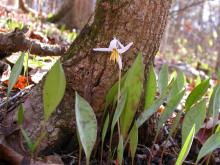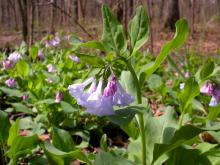Wildflowers, Grasses and Other Nonwoody Plants
Media

Species Types
Scientific Name
Perilla frutescens
Description
Introduced as an ornamental, beefsteak plant is native to Asia. It is common in moist or dry wooded bottomlands, open valley pastures, and along trails, railroads, and roadsides. It spreads invasively in our state.
Media

Species Types
Scientific Name
Medicago lupulina
Description
The small, cloverlike flowering heads and trifoliate leaves of black medick are clues that this plant is in the Fabaceae, the bean or pea family. An introduced, weedy species, it is closely related to alfalfa.
Media

Species Types
Scientific Name
Erythronium albidum
Description
White dogtooth violet, or white trout lily, is a small, early blooming lily that lives in wooded areas. Its flowers are white and its narrow leaves are purplish or brownish mottled. They are often found as a colony of blade-shaped, green-and-brown-mottled leaves poking out of the earth in spring, with only a few producing flowers.
Media

Species Types
Scientific Name
Mertensia virginica
Description
One of our most stunning early spring wildflowers, bluebells is also a popular native plant for gardening. As with all native plant gardening, make sure you get your plants from ethical sources.
Media

Species Types
Scientific Name
Cirsium vulgare
Description
Bull thistle is a weedy introduction from Europe, found statewide. To tell it from our other thistles, note its stems with spiny-margined wings, and its leaves with the upper surface strongly roughened with stiff, spiny bristles.
Media

Species Types
Scientific Name
Hibiscus lasiocarpos
Description
Hibiscus in Missouri? You bet! Hairy rose mallow is a native perennial whose 6-inch-wide blossoms look a lot like those of its tropical relatives. The stalks can get woody and can grow to 8 feet tall.
Media

Species Types
Scientific Name
Impatiens capensis
Description
Many Missouri children learn about this orange-flowered native plant by playing with the juicy green seedpods, which, when ripe, "explode" upon the slightest touch. This is jewelweed's mechanism for seed dispersal, and it's the reason for the name "touch-me-not."
Media

Species Types
Scientific Name
Ludwigia peploides
Description
Water primrose is a common shoreline plant with bright yellow flowers and long, trailing stems. It grows in dense mats in the shallow areas of ponds, lakes, and streams.
Media

Species Types
Scientific Name
Impatiens pallida
Description
Our two Missouri jewelweeds occur in the same habitats, often side by side, and even botanists can’t tell them apart without the flowers. Pale touch-me-not is the one with the lemon-yellow flowers!
Media

Species Types
Scientific Name
Lythrum salicaria
Description
Anyone who’s seen what purple loosestrife has done to New England and the Northeast can tell you how invasive this plant is. Learn how to identify it, so you can report any findings to the Missouri Department of Conservation.
See Also
About Wildflowers, Grasses and Other Nonwoody Plants in Missouri
A very simple way of thinking about the green world is to divide the vascular plants into two groups: woody and nonwoody (or herbaceous). But this is an artificial division; many plant families include some species that are woody and some that are not. The diversity of nonwoody vascular plants is staggering! Think of all the ferns, grasses, sedges, lilies, peas, sunflowers, nightshades, milkweeds, mustards, mints, and mallows — weeds and wildflowers — and many more!





















